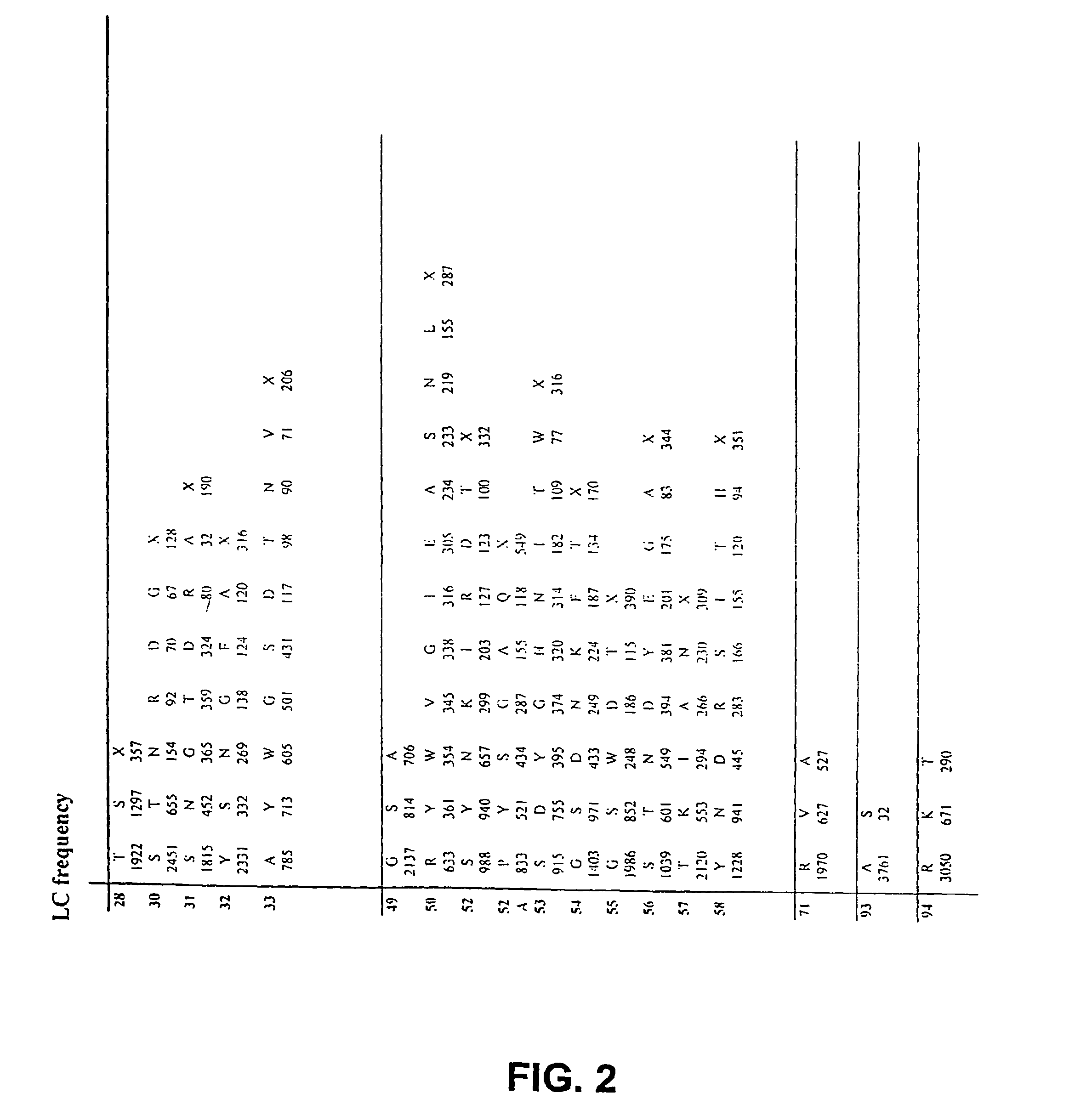Synthetic antibody phage libraries
a technology of synthetic antibodies and phage libraries, applied in the field of antibodies, can solve the problems of inability to apply systematic and quantitative methods, inability to efficiently generate, and inability to efficiently identify high affinity binders, etc., and achieves the effects of rapid identification of high affinity binders, efficient generation, and rapid production
- Summary
- Abstract
- Description
- Claims
- Application Information
AI Technical Summary
Benefits of technology
Problems solved by technology
Method used
Image
Examples
example 1
[0327]Vectors encoding fusion polypeptides comprising variant CDRs were constructed as follows.
Antibody Phage Display Vectors Based on pS1607
[0328]A vector for antibody phage display was constructed by modifying vector pS1607 (Sidhu et al., J. Mol. Biol. (2000), 296:487-495). Vector pS1607, which has pTac promoter sequence and malE secretion signal sequence, contained a sequence of human growth hormone fused to the C-terminal domain of the gene-3 minor coat protein (p3). The sequence encoding hGH was removed, and the resulting vector sequence served as the vector backbone for construction of vectors of the present invention that contain DNA fragments encoding the anti-her2 humanized antibody 4D5 light chain and heavy chain variable domain sequences in the form of:
[0329](i) single chain Fv (scFv) (SEQ ID NO: 23; FIG. 14);
[0330](ii) single chain Fv with zipper domain (scFvzip) (SEQ ID NO: 24; FIG. 15);
[0331](iii) Fab fragment (Fab) (SEQ ID NO: 25; FIG. 16);
or
[0332](iv) Fab fragment wi...
example 2
Modifications to Dimerization Domains
[0351]A series of mutations were made in the dimerizing domain, which for example, include the hinge region plus GCN4 leucine zipper for constructs such as Fab-zip as described in Example 1. The mutations were made to the dimerization domain to determine if both a disulfide bond as well as the zipper region were important to the display of F(ab′)2 or ScFV2.
[0352]A series of mutations (FIG. 39) was made in the dimerization domain, i.e. hinge region plus GCN4 leucine zipper, and their effects on avidity were examined (FIG. 40). The phagemid vector phGHam.g3 with alkaline phosphatase (phoA) promoter was used as described previously since it is less toxic to bacterial cells and increases the phage yield compared to a vector with Ptac promoter (C. V. Lee, unpublished observation). The solution binding of all constructs was first examined to make certain the change in the construct did not disrupt the folding and function of the Fab. IC50s for all vari...
example 3
[0365]Libraries of antibody variable domains were generated to isolate and screen for isolation of high affinity binders to particular target antigens. Diversity of antibody variable domains is preferably generated in CDR regions of the heavy and / or light chain variable domains. Generation of diversity in CDR regions of heavy chains is described below. Utilization of a single template molecule as the backbone for generation of the diversity in CDR regions is preferred because the single template can be modified to improve display and folding and may accommodate H3 regions of various sizes.
Library Design
H1, H2
[0366]Libraries of antibody variable domains were designed to maximize diversity in the heavy chain CDR regions while minimizing structural perturbations in the antibody variable domains. Structural perturbations in antibody variable domains are generally associated with improperly folded antibody domains resulting in low yield and unstable products, for example when produced in...
PUM
| Property | Measurement | Unit |
|---|---|---|
| pH | aaaaa | aaaaa |
| pH | aaaaa | aaaaa |
| size | aaaaa | aaaaa |
Abstract
Description
Claims
Application Information
 Login to View More
Login to View More - R&D
- Intellectual Property
- Life Sciences
- Materials
- Tech Scout
- Unparalleled Data Quality
- Higher Quality Content
- 60% Fewer Hallucinations
Browse by: Latest US Patents, China's latest patents, Technical Efficacy Thesaurus, Application Domain, Technology Topic, Popular Technical Reports.
© 2025 PatSnap. All rights reserved.Legal|Privacy policy|Modern Slavery Act Transparency Statement|Sitemap|About US| Contact US: help@patsnap.com



